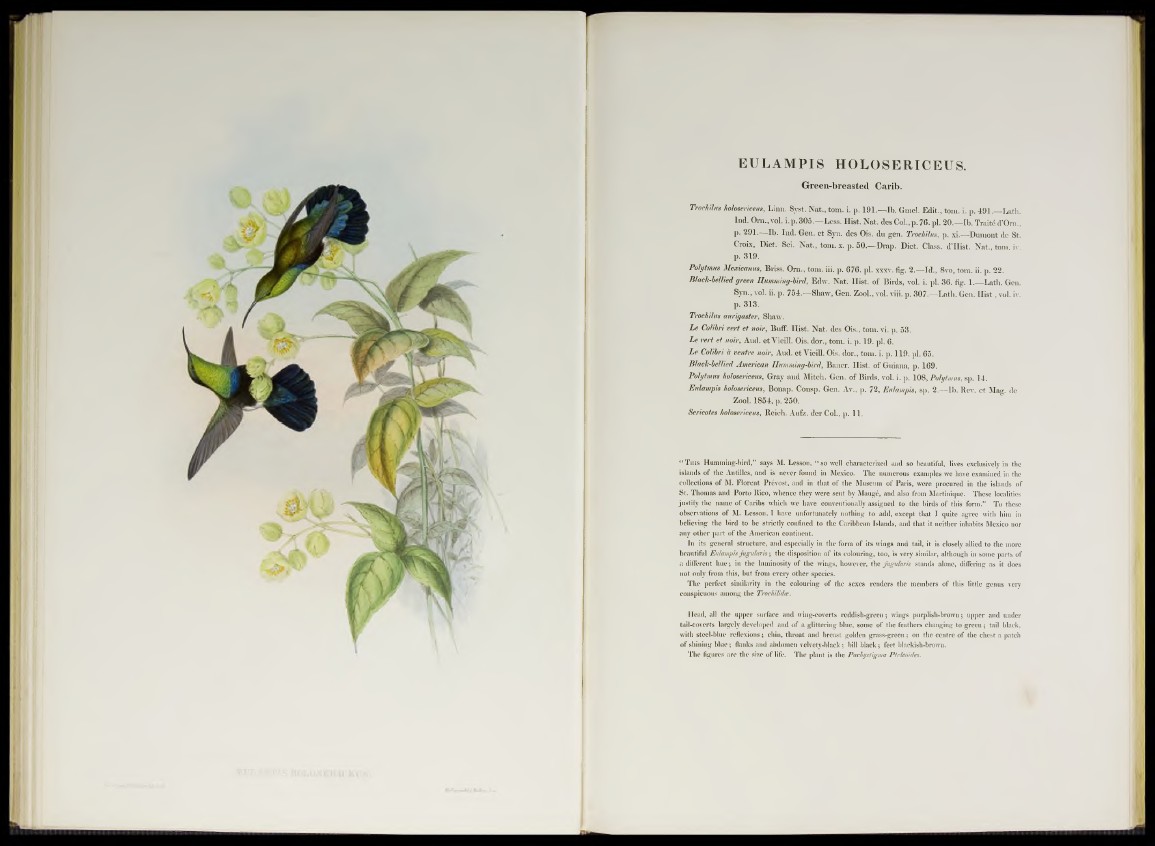
EULAMPIS HOLOSERICEUS .
Green-breasted Carib.
Trochilus kolosericem, Linn. Syst. N at., tom. i. p. 191.—Ib. Gmel. Edit., tom. i. p. 491.—Lath.
Ind. Om., vol. i.p.305.—Less. Hist. Nat. des Col.,p. 76. pl. 20.—Ib. Traité d’Om.,
p. 291.—Ib. Ind. Gen. et Syn. des Ois. du gen. Trochilus, p. xi.—Dumont de St.
Croix, Diet. Sei. Nat., tom. x. p. 50.—Drap. Diet. Class. d’Hist. Nat., tom. iv.
p. 319.
Polytmus Mexicanus, Briss. Om., tom. iii. p. 676. pl. xxxv. fig. 2.—ld., 8vo, tom. ii. p. 22.
Black-bellied green Humming-bird, Edw. Nat. Hist. of Birds, vol. i. pl. 36. fig. 1.—Lath. Gen.
Syn., vol. ii. p. 754.—Shaw, Gen. Zool., vol. viii. p. 307.—Lath. Gen. H is t, vol. iv.
p. 313.
Trochilus aurigaster, Shaw.
Le Colibri verf et noir, Buff. Ilist. Nat. des Ois., tom. vi. p. 53.
Le vert et noir, Aud. etVieill. Ois. dor., tom. i. p. 19. pl. 6.
Le Colibri a ventre noir, Aud. etVieill. Ois. dor., tom. i. p. 119. pl. 65.
Black-bellied American Humming-bird, Bancr. Hist. of Guiana, p. 169.
Polytmus holosericeus, Gray and Miteh. Gen. of Birds, vol. i. p. 108, Polytmus, sp. 14.
Eulampis holosericeus, Bonap. Consp. Gen. Av., p. 72, Eulampis, sp. 2.—Ib. Rev. et Mag. de
Zool. 1854, p. 250.
Seiicotes holosericeus, Reich. Aufz. der Col., p. 11.
“ T his Humming-bird,” says M. Lesson, “ so well characterized and so beautiful, lives exclusively in the
islands of the Antilles, and is never found in Mexico. The numerous examples we have examined in the
collections of M. Florent Prévost, and in that of the Museum of Paris, were procured in the islands of
St. Thomas and Porto Rico, whence they were sent by Maugé, and also from Martinique. These localities
justify the name of Caribs which we have conventionally assigned to the birds of this form.” To these
observations of M. Lesson, I have unfortunately nothing to add, except that I quite agree with him in
believing the bird to be strictly confined to the Caribbean Islands, and that it neither inhabits Mexico nor
any other part of the American continent.
In its general structure, and especially in the form of its wings and tail, it is closely allied to the more
beautiful Eulampis jugularis; the disposition of its colouring, too, is very similar, although in some parts of
a different hue; in the luminosity of the wings, however, the jugularis stands alone, differing as it does
not only from this, but from every other species.
The perfect similarity in the colouring of the sexes renders the members of . this little genus very
conspicuous among the Trochilidce.
Head, all the upper surface and wing-coverts reddish-green; wings purplish-brown; upper and under
tail-coverts largely developed and of a glittering blue, some of the feathers changing to green; tail black,
with steel-blue reflexions; chin, throat and breast golden grass-green; on the centre of the chest a patch
of shining blue; flanks and abdomen velvety-black; bill black; feet blackish-brown.
The figures are the size of life. The plant is the Pacliystigma Pteleoïdes.